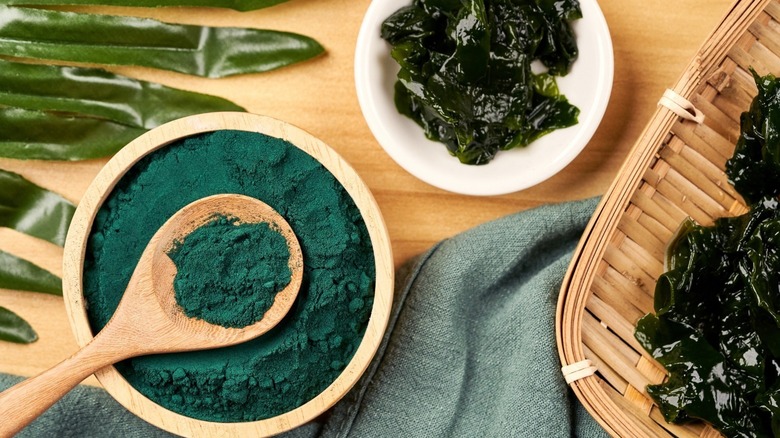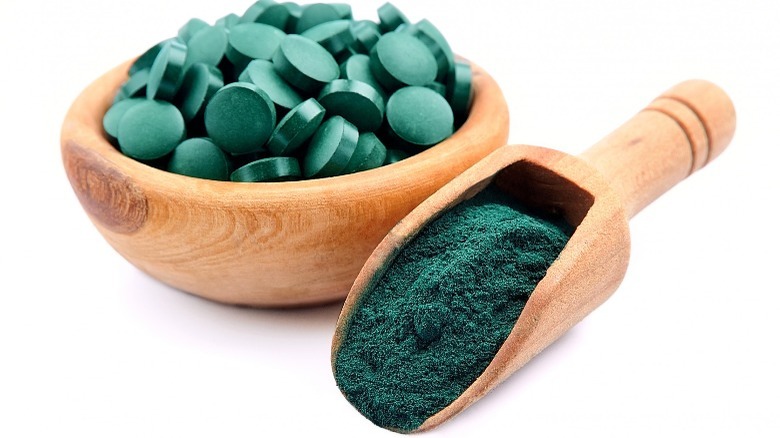Why You Should Be Eating More Spirulina
You may associate eating algae with fish, crabs, snails, and other aquatic (aka non-human) organisms. However, a blue-green alga called spirulina has been consumed by humans for centuries for its nutritional benefits, dating all the way back to the Aztecs. According to WebMD, they used spirulina on long-distance runs and to help people recover from diseases. Algae consumption has also been reported in ancient Chile, China, and Ireland, notes the Journal of Applied Phycology.
From ancient roots, algae have made their way into our modern-day diet as well, and the market for seaweed snacks is thriving. In 2013, $6.7 billion of seaweed was harvested around the world, and in 2012, at least around 38% of the global seaweed harvest was consumed as food (via the Journal of Applied Phycology). Spirulina, another type of algae, became well-known for its use by astronauts due to its anti-inflammatory and immune-boosting properties. Bringing food to space is very costly, reports Insider, so spirulina is a valuable supplement to space travelers for the high amount of nutritional value it packs into a relatively small package. But even down here on Earth, the superfood is nothing to sneeze at (and not just because of its antiallergic properties).
Spirulina is a nutrient-packed powerhouse
So why exactly is spirulina such a valuable addition to your diet? It's packed (gram for gram, more packed than just about any other food in the world) with various nutrients essential in our daily diets and the proper functioning of an array of biological systems, like protein, copper, iron, and magnesium (via Healthline). In fact, spirulina has been recognized as having as much or more protein than many vegetables and even eggs – Harvard Medical School states that the alga contains a whopping 60% protein. So as long as its deep-sea color doesn't discourage you, spirulina may be an excellent addition to your next protein shake.
In addition, Healthline highlights that spirulina is an exceptional source of antioxidants (the main one is called phycocyanin); it's actually these antioxidant properties that give spirulina the vibrant color it's known for. But they exist for function as much as fashion: Per WebMD, antioxidants are important for combating cancer, high blood pressure, and other conditions that can sometimes arise from oxidative stress. They can also protect your eyes as you age and reduce your risk of heart disease.
Spirulina can lower cholesterol and fight disease
Although many protein-rich foods, like red meats, are commonly associated with increased cholesterol, spirulina is not only high in protein but has been known to simultaneously lower "bad" cholesterol as well as prevent it from oxidizing, according to Healthline; this oxidation is a big contributor to the development of heart disease.
But that's just the beginning: A 2013 study in the Journal of Medicinal Food states that spirulina and other blue-green algae have "antiviral, antitumor, antioxidant, anti-inflammatory, antiallergic, antidiabetic, and antibacterial properties" — basically, "anti-" all the scary stuff — and that spirulina can be a powerful additive for fighting cardiovascular and liver disease. It even holds promise for blood pressure regulation in both the short-term and long-term treatment of diabetes.
With all that in mind, does eating aquatic-looking algae sound appealing? Many don't love the taste of spirulina, which is described by The Big Carrot (via Unicorn Superfoods) as "a mouthful of lake water ... green and earthy with a slightly sulfuric edge" (yum?). As a result, spirulina is best added to other foods that mask the taste, such as smoothies or soups. It often comes in the form of powder, although sometimes it can be found in capsules and tablets as well. However you eat it, don't let the taste deter you — it's worth dabbling in algae for spirulina's extraordinary nutritional benefits.


